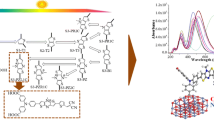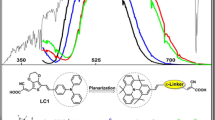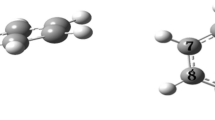Abstract
Four novel Donor-π-Acceptor (D-π-A) type dyes have been drafted and theoretically assessed via densityfunctional theory (DFT) and time-dependent density functional theory (TDDFT).The optoelectronic as well as photovoltaic parameters of four organic dyes based on phenylnaphthalen-1-amine as the donor and cyanoacrylic acid as acceptor unit has been investigated. These two groups stay unchanged for all proposed dyes whereas the π-linker was varied to investigate potential impact on the absorption spectra and photovoltaic (PV) properties. The calculated electronic levels by MPW1PW91 functional in conjunction with 6-31G (d, p) basis set in the gaseous as well as solvent medium show that the solvent influences the photophysical properties of the dyes. The findings obtained from this report indicated that all designed molecules would be excellent sensitizers, because of the narrow bandgap, efficient photo-induced electron transfer, low exciton binding energy along with a redshift. Accordingly, these theoretical calculations can provide a strategy for the construction of new promising sensitizers for DSSC.





Similar content being viewed by others
References
Adamo, C., Barone, V.: Exchange functionals with improved long-range behavior and adiabatic connection methods without adjustable parameters: the mPW and mPW1PW models. J. Chem. Phys. 108, 664–675 (1998)
Algerienne, R. Et, D.: Contribution to the study of the dye effect on the conversion efficiency of DSSCs (2020)
AlGhamdi, J. M., AlOmar, S., Gondal, M. A., Moqbel, R., Dastageer, M. A.: Enhanced efficiency of dye co-sensitized solar cells based on pulsed-laser-synthesized cadmium-selenide quantum dots Sol. Energy 209 108–117 (2020). https://doi.org/10.1016/j.solener.2020.08.091
Aswaniya, K., Raj, M. B. J., Gowri, S., Vinitha, G.: Promising computational, structural, vibrational and optical properties of piperazinium bis(2-carboxypyridine)monohydrate (PBCPM) crystal for NLO device applications. Optik (stuttg) 246 167836 (2021). https://doi.org/10.1016/j.ijleo.2021.167836
Azaid, A., Abram, T., Kacimi, R., Sbai, A., Lakhlifi, T., Bouachrine, M.: Organic materials based with D– π –A structure based on thiophene and anthracene for application in dye-sensitized solar cells Mater. Today Proc. 45 7363–9 (2021). https://doi.org/10.1016/j.matpr.2021.01.119
Bouhadoun, S.: Synthèse de nanoparticules de dioxyde de titane par pyrolyse laser et leur application en photocatalyse To cite this version : HAL Id : tel-01275433 These De Doctorat De L ’ Universite Paris -Saclay , préparée à “ Université Paris - Sud ” Mme Sarah Bouhad (2016)
Bourass, M., Komiha, N., Kabbaj, O. K., Wazzan, N., Chemek, M., Bouachrine, M.: The photophysical properties and electronic structures of bis[1]benzothieno[6,7-: D:6′,7′- d ′]benzo[1,2- b:4,5- b ′]dithiophene (BBTBDT) derivatives as hole-transporting materials for organic light-emitting diodes (OLEDs). New J. Chem. 43 15899–15909 (2019). https://doi.org/10.1039/c9nj02756d
Chua, M. H., Zhu, Q., Tang, T., Shah, T. W., Xu, J.: Diversity of electron acceptor groups in donor–acceptor type electrochromic conjugated polymers. Sol. Energy Mater. Sol. Cells 197 32–75 (2019)
Colombo, A., Dragonetti, C., Roberto, D., Ugo, R., Manfredi, N., Manca, P.: A carbon doped anatase TiO2 as a promising semiconducting layer in Ru-dyes based dye-sensitized solar cells Inorganica Chim. Acta 489 263–268 (2019)
Dennington, R., Keith, T., Millam, J.: GaussView, version 5 (2009)
Ding, Y., Li, J., Liu, S., Tan, Y., Shi, K., Jiao, Y.: New phenothiazine dyes containing benzothiadiazole-acceptor for dye-sensitized solar cells. Dye Pigment 194 109664 (2021). https://doi.org/10.1016/j.dyepig.2021.109664
Fonkem, C., Ejuh, G. W., Tchangnwa Nya, F., Yossa Kamsi, R. A., Ndjaka, J. M. B.: Theoretical study of optoelectronic properties of the molecule 2-cyano-3-[4-(diphenylamino)phenyl] acrylic acid J. Iran Chem. Soc. 17, 533–543 (2020). https://doi.org/10.1007/s13738-019-01790-4
Frisch, E., Hratchian, H. P., Dennington, R. D. II, Keith, T. A., Millam, J., Nielsen, B., Holder, A. J., Hiscocks, J.: GaussView Version 5.0. 8, Gaussian (2009)
Gao, F.-W., Qu, C.-L., Zhang, R.-K., Shi, L., Su, Z.-M.: Doping alkali metal ions and introducing electron donor groups to fulleropyrrolidine derivatives: Large second-order nonlinear optical responses Comput. Theor. Chem. 1201, 113254 (2021). https://doi.org/10.1016/j.comptc.2021.113254
Ghanavatkar, C.,W., Mishra, V. R., Sekar, N.: Review of NLOphoric azo dyes – developments in hyperpolarizabilities in last two decades. Dye Pigment 191 109367 (2021).https://doi.org/10.1016/j.dyepig.2021.109367
Joly, D., Pellejà, L., Narbey, S., Oswald, F., Chiron, J., Clifford, J. N.: A robust organic dye for dye sensitized solar cells based on iodine/iodide electrolytes combining high efficiency and outstanding stability. Sci. Rep. 4, 1–7 (2014).
Jordaan, M. A., Ebenezer, O., Mthiyane, K., Damoyi, N., Shapi, M.: Amide [Formula presented] imidic prototropic tautomerization of efavirenz, NBO analysis, hyperpolarizability, polarizability and HOMO–LUMO calculations using density functional theory. Comput. Theor. Chem. 1201, 113273 (2021). https://doi.org/10.1016/j.comptc.2021.113273
Kacimi, R., Abram, T., Saidi, W., Bejjit, L., Bouachrine, M.: New organic molecular based on Bis-Dipolar Diphenylamino-EndcappedOligo aryl fluorene application for organic solar cells Mater. Today Proc. 13, 1178–1187 (2019). https://doi.org/10.1016/j.matpr.2019.04.086
Kacimi, R., Abram, T., Bejjit, L., Bouachrine, M.: New organic materiel based on benzothiadiazole for photovoltaic application solar cells Mater. Today Proc. 13, 1188–1196 (2019)
Kacimi, R., Chemek, M., Azaid, A., Bennani, M. N., Alimi, K., Bejjit, L.: Organic materials based on thiophene and benzothiadiazole for organic solar cells. Comput. Investig. 5, 1–11 (2020)
Kacimi, R., Bourass, M., Toupance, T., Wazzan, N., Chemek, M., Alamy El, A.: Computational design of new organic (D–π–A) dyes based on benzothiadiazole for photovoltaic applications, especially dye-sensitized solar cells. Res. Chem. Intermed. 46 3247–3262 (2020). https://doi.org/10.1007/s11164-020-04150-7
Kacimi, R., Raftani, M., Abram, T., Azaid, A., Ziyat, H., Bejjit, L., et al.: Theoretical design of D-π-A system New dyes candidate for DSSC application. Heliyon. 7, e07171 (2021). https://doi.org/10.1016/j.heliyon.2021.e07171
Kang, S. H., Jeong, M. J., Eom, Y. K., Choi, I. T., Kwon, S. M., Yoo, Y.: Porphyrin sensitizers with donor structural engineering for superior performance dye-sensitized solar cells and tandem solar cells for water splitting applications. Adv. Energy Mater. 7, 1602117 (2017)
Kosar, B., Albayrak, C.: Spectroscopic investigations and quantum chemical computational study of (E)-4-methoxy-2-[(p-tolylimino)methyl]phenol. Spectrochim. Acta Part A Mol. Biomol. Spectrosc. 78, 160–167 (2011). https://doi.org/10.1016/j.saa.2010.09.016
Kte’pi, B.: Environmental science. Green Technol An A-to-Z Guid 2012. https://doi.org/10.4135/9781412975704.n47
Li, S.-R., Lee, C.-P., Liao, C.-W., Su, W.-L., Li, C.-T., Ho, K.-C.: Structural engineering of dipolar organic dyes with an electron-deficient diphenylquinoxaline moiety for efficient dye-sensitized solar cells. Tetrahedron 70, 6276–6284 (2014)
Mathew, S., Yella, A., Gao, P., Humphry-Baker, R., Curchod, B. F. E., Ashari-Astani, N.: Dye-sensitized solar cells with 13% efficiency achieved through the molecular engineering of porphyrin sensitizers. Nat. Chem. 6, 242–247 (2014). https://doi.org/10.1038/nchem.1861
Muhammad, S., Lai, C. H., Al-Sehemi, A. G., Alshahrani, T., Iqbal, J., Ayub, K.: Exploring the twisted molecular configurations for tuning their optical and nonlinear optical response properties: a quantum chemical approach. J. Mol. Graph. Model. 102, 107766 (2021) https://doi.org/10.1016/j.jmgm.2020.107766
Muhammad Asif Iqbal, M., Yasir Mehboob, M., Hussain, R., Adnan, M., Irshad, Z.: Synergistic effects of fluorine, chlorine and bromine-substituted end-capped acceptor materials for highly efficient organic solar cells. Comput. Theor. Chem. 1202, 113335 (2021)
Ninis, O., Kacimi, R., Bouaamlat, H., Abarkan, M., Bouachrine, M.: Theoretical studies of photovoltaic properties for design of new Azo-Pyrrole photo-sensitizer materials as dyes in solar cells. J. Mater. Environ. Sci. 8, 2572–2578 (2017).
Noh, H. J., Ji, J. M., Hwang, S. P., Kim, C. H., Kim, H. K. : D-π-A-structured organic sensitizers with π-extended auxiliary acceptor units for high-performance dye-sensitized solar cells. Dye Pigment. 195, 109681 (2021). https://doi.org/10.1016/j.dyepig.2021.109681
Ouared, I., Rekis, M., Trari, M.: Phenothiazine based organic dyes for dye sensitized solar cells: a theoretical study on the role of π-spacer. Dye Pigment 190, 6–11 (2021). https://doi.org/10.1016/j.dyepig.2021.109330
Panneerselvam, M., Kathiravan, A., Solomon, R. V., Jaccob, M: The role of π-linkers in tuning the optoelectronic properties of triphenylamine derivatives for solar cell applications - a DFT/TDDFT study. Phys. Chem. Chem. Phys. 19, 6153–6163 (2017). https://doi.org/10.1039/c6cp07768d
Park, B., Moon, J.: Technology forecast of dye sensitized solar cell as a sustainable future energy. Procedia Comput. Sci. 122, 965–968 (2017). https://doi.org/10.1016/j.procs.2017.11.461
Park, J. M., Jung, C. Y., Wang, T., Choi, H. D., Park, S. J., Ou, P.: Effect of regioisomeric substitution patterns on the performance of quinoxaline-based dye-sensitized solar cells. Electrochim. Acta 298, 650–662 (2019)
Privado, M., Cruz de la, P., Malhotra, P., Sharma, G. D., Langa, F.: Influence of the dipole moment on the photovoltaic performance of polymer solar cells employing non-fullerene small molecule acceptor. Sol. Energy 221, 393–401 (2021). https://doi.org/10.1016/j.solener.2021.04.049
Raftani, M., Abram, T., Kacimi, R., Bennani, M. N., Bouachrine, M.: Organic compounds based on pyrrole and terphenyl for organic light-emitting diodes ( OLED ) applications : design and electro-optical properties. J. Mater. Environ. Sci. 11, 933–946 (2020)
Sadasivuni, K. K., Deshmukh, K., Ahipa, T. N., Muzaffar, A., Ahamed, M. B., Pasha, S. K. K.: Flexible, biodegradable and recyclable solar cells: a review. J. Mater. Sci. Mater. Electron. 30, 951–974 (2019). https://doi.org/10.1007/s10854-018-0397-y
Saidi, N. M., Farhana, N. K., Ramesh, S., Ramesh, K.: Influence of different concentrations of 4-tert-butyl-pyridine in a gel polymer electrolyte towards improved performance of Dye-Sensitized Solar Cells (DSSC). Sol. Energy 216, 111–119 (2021). https://doi.org/10.1016/j.solener.2020.12.058
Sarikavak, K., Kurtay, G., Sevin, F., Güllü, M.: Molecular engineering of thienothiophene or dithienopyrrole-based π-spacers for dye-sensitized solar cells (DSSCs) with D-π-A architecture: a DFT/TD-DFT study. Comput. Theor. Chem. 1201, 113275 (2021). https://doi.org/10.1016/j.comptc.2021.113275
Selmy, A. E., Soliman, M., Allam, N. K.: Refractory plasmonics boost the performance of thin-film solar cells. Emergent. Mater. 1, 185–191 (2018). https://doi.org/10.1007/s42247-018-0017-x
Shi, X., Yang, Y., Wang, L., Li, Y.: Introducing asymmetry induced by benzene substitution in a rigid fused π spacer of dπ-A-type solar cells: a computational investigation. J. Phys. Chem. C 123, 4007–4021 (2019). https://doi.org/10.1021/acs.jpcc.8b10963
Sikandar, R., Farhat, A., Khera, R. A., Jabeen, S., Ayub, A. R., Langer, P.: Tuning the optoelectronic properties of oligothienyl silane derivatives and their photovoltaic properties. J. Mol. Graph. Model. 106, 107918 (2021)
Vuai, S.A.H., Khalfan, M.S., Babu, N.S.: DFT and TD-DFT studies for optoelectronic properties of coumarin based donor-π-acceptor (D-π-A) dyes: applications in dye-sensitized solar cells (DSSCS). Heliyon 7, e08339 (2021). https://doi.org/10.1016/j.heliyon.2021.e08339
Yanai, T., Tew, D. P., Handy, N. C.: A new hybrid exchange–correlation functional using the Coulomb-attenuating method (CAM-B3LYP). Chem. Phys. Lett. 393, 51–57 (2004)
Zaier, R., Gharbi, S., Hriz, K., Majdoub, M., Ayachi, S.: New fluorescent material based on anthracene and triazole for blue organic light emitting diode: a combined experimental and theoretical study. J. Mol. Liq. 116984, 116984 (2021). https://doi.org/10.1016/j.molliq.2021.116984
Zhang, C.-R., Liu, Z.-J., Chen, Y.-H., Chen, H.-S., Wu, Y.-Z., Feng, W.: DFT and TD-DFT study on structure and properties of organic dye sensitizer TA-St-CA. Curr. Appl. Phys. 10, 77–83 (2010)
硕士研究生: 段程皓. 有机及钙钛矿太阳能电池的界面工程 Interface engineering of organic and perovskite solar cells. 硕士学位论文 (2018)
Acknowledgements
We are thankful to the “Association Marocaine des Chimistes Theoriciens” (AMCT) for its appropriate assistance.
Author information
Authors and Affiliations
Corresponding author
Additional information
Publisher's Note
Springer Nature remains neutral with regard to jurisdictional claims in published maps and institutional affiliations.
This article is part of the Topical Collection on Optical and Quantum Sciences in Africa.
Guest edited by Salah Obayya, Alex Quandt, Andrew Forbes, Malik Maaza, Abdelmajid Belafhal and Mohamed Farhat.
Rights and permissions
About this article
Cite this article
Kacimi, R., Iqbal, J., Louazri, L. et al. Drafting novel N-phenylnaphthalen-1-amine-based dyes for designing highly proficient organic solar cells: theoretical investigation of the π-linker influence on photovoltaic properties. Opt Quant Electron 54, 119 (2022). https://doi.org/10.1007/s11082-021-03503-9
Received:
Accepted:
Published:
DOI: https://doi.org/10.1007/s11082-021-03503-9




